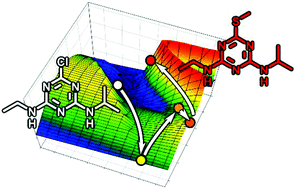Constrained evolution of a bispecific enzyme: lessons for biocatalyst design†
Abstract
One of the central goals of protein design and engineering is to be able to accurately predict the effects of a mutation on stability and activity. However, the genetic context into which mutations are introduced can lead to complex interactions between the mutation and other amino acids and unpredictable, non-additive, effects. This phenomenon is known as intramolecular epistasis and has been shown to restrict evolutionary paths through laboratory directed evolution experiments and ancestral protein reconstruction, but has rarely been studied at a quantitative level in naturally evolving enzymes. Atrazine-specific and atrazine/ametryn bispecific triazine hydrolases (TrzN) have evolved in different bacterial strains over the past fifty years in response to the presence of the synthetic herbicides atrazine and ametryn. Here, we have investigated all 24 evolutionary trajectories that are possible from monofunctional to bispecific TrzN isoforms in terms of activity, stability, expression and structure. The results reveal that half of these trajectories are unviable due to inactive intermediates, with only 1/24 trajectories exhibiting consistent improvement in bispecificity. The most viable path requires the mutation of Gln241 to Glu241 first, which increases activity 3-fold with atrazine and 105-fold with ametryn, which is further optimised in subsequent evolutionary steps. The epistatic interactions between mutations, involving control of the pKa of catalytic residues, the thermostability of the protein, and soluble expression are shown to be responsible for the bottlenecks in this evolutionary landscape. This comprehensive analysis of the evolution of bispecificity highlights the importance of epistasis in protein engineering and evolution, which makes identifying the correct sequence in which to combine mutations extremely important.

- This article is part of the themed collection: Biocatalysis: Natural and biologically inspired synthetic enzymes


 Please wait while we load your content...
Please wait while we load your content...